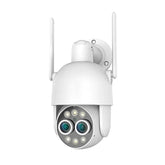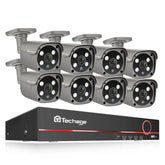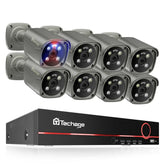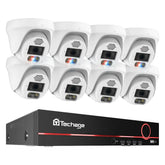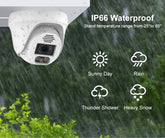The Evolution of IP Cameras: Transforming Surveillance Technology
The world of surveillance has undergone a remarkable transformation with the evolution of IP cameras. From their humble beginnings to the advanced systems we have today, The field of video surveillance has witnessed significant advancements , with the advent of IP cameras revolutionizing the way we capture and analyze video footage. IP cameras, also known as network cameras, have replaced traditional analog systems due to their numerous advantages in terms of flexibility, scalability, image quality, and advanced functionalities.In this comprehensive blog post, we will explore the fascinating journey of IP cameras, tracing their evolution from analog to digital and discussing the profound impact they have had on surveillance technology, and delve into the advantages they offer over analog systems.
Evolution of IP Cameras:
IP cameras have come a long way since their inception. Initially, they were developed as standalone devices with limited capabilities. However, with advancements in technology, IP cameras have become highly sophisticated devices equipped with powerful processors, advanced sensors, and embedded software. These cameras utilize the Internet Protocol (IP) to transmit video and audio data over computer networks, enabling remote access and management.
Analog Era:
The history of IP cameras can be traced back to the era of analog surveillance systems. Analog cameras were the primary means of capturing video footage for surveillance purposes. These cameras used analog signals, which were transmitted over coaxial cables to recording devices such as Video Cassette Recorders (VCRs) or Digital Video Recorders (DVRs). While these systems served their purpose, they were limited in terms of image quality, scalability, and functionality.
The Emergence of IP Cameras:
The emergence of IP cameras marked a significant turning point in surveillance technology. IP cameras, also known as network cameras, revolutionized the industry by capturing and transmitting digital video data over IP networks. This shift from analog to digital technology brought about a multitude of benefits that have forever changed the landscape of surveillance.

Advantages of IP Cameras over Analog Systems:
Superior Image Quality:
One of the most notable advancements offered by IP cameras is their ability to deliver superior image quality. Unlike analog cameras, which had limited resolution capabilities, IP cameras offered high-definition imaging. With advanced sensors and image processing technologies, IP cameras captured clear and detailed video footage, allowing for precise identification of individuals, objects, and critical details. This improvement in image quality has been instrumental in enhancing the effectiveness of surveillance systems and improving overall security.
Flexibility and Scalability:
IP cameras introduced a new level of flexibility and scalability to surveillance systems. Unlike their analog counterparts, which required dedicated cables for each camera, IP cameras utilized existing network infrastructure, such as Ethernet cables or Wi-Fi connections. This eliminated the need for extensive cabling and allowed for a more streamlined installation process. Furthermore, IP camera systems could easily accommodate additional cameras as needed, making them highly scalable to suit the evolving needs of any property.
Remote Access and Monitoring:
IP cameras revolutionized the way surveillance systems were accessed and monitored. By leveraging the power of IP networks, users gained the ability to remotely access live video feeds and camera controls from anywhere with an internet connection. This remote accessibility provided property owners and security personnel with real-time surveillance capabilities, enabling them to respond promptly to potential security threats. Whether checking camera feeds from a computer, smartphone, or tablet, remote access empowered individuals to monitor their properties even when physically absent, ensuring a constant watchful eye on their surroundings.
Advanced Features and Intelligent Analytics:
IP cameras brought a host of advanced features and intelligent analytics to the realm of surveillance. These features further enhanced the capabilities of IP camera systems and revolutionized the way security was managed. Motion detection technology enabled cameras to automatically detect and track movement, triggering alerts or recording video when activity was detected. Facial recognition capabilities allowed for the identification of known individuals or the detection of unauthorized persons, providing an additional layer of security. Advanced analytics algorithms could be applied to video footage, enabling behavior analysis, object tracking, and even predictive analytics. These intelligent features and analytics transformed IP cameras from passive observers to proactive security tools.
Integration with Other Systems:
IP cameras seamlessly integrated with other security systems, amplifying their effectiveness and enhancing overall security measures. By integrating with access control systems, alarm systems, and video management software, IP cameras became an integral part of a comprehensive security ecosystem. For example, when an access control system detected an unauthorized entry, IP cameras could be programmed to automatically focus on the corresponding area, capturing video evidence in real-time. This integration ensured a cohesive and synchronized approach to security management, where different components worked together to provide a robust and efficient surveillance solution.
Expanded Storage Capabilities:
Digital surveillance systems, including IP cameras, brought about expanded storage capabilities. IP cameras allowed for video footage to be stored locally on onboard storage devices or network-attached storage (NAS) systems. Additionally, cloud-based storage solutions provided scalable and secure options for storing and accessing recorded video footage. This expanded storage capacity allowed for longer retention periods and easy retrieval of specific footage, which was crucial for investigations, evidence preservation, and compliance with legal requirements.
Cost-Effectiveness:
While IP cameras may have a higher upfront cost compared to analog cameras, they offer long-term cost-effectiveness. IP cameras eliminate the need for expensive coaxial cables and additional infrastructure. Furthermore, the scalability and flexibility of IP systems reduce installation and maintenance costs over time. Additionally, the advanced analytics provided by IP cameras can contribute to more efficient resource allocation and incident prevention, further reducing costs.
The evolution of IP cameras has transformed the world of surveillance, delivering unprecedented levels of image quality, flexibility, scalability, remote accessibility, advanced features, and integration capabilities. The transition from analog to digital technology revolutionized the way we monitor and protect our surroundings, making surveillance systems more efficient, proactive, and effective. As technology continues to advance, we can expect further innovations in IP camera technology, pushing the boundaries of what is possible in the field of surveillance. Embrace the evolution of IP cameras and leverage their power to create a safer and more secure environment for everyone. The journey from analog to digital surveillance has forever changed the way we view and protect the world around us.




